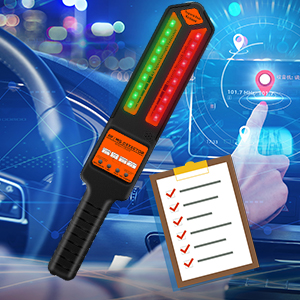Unmasking the Invisible: 5 Expert Tips for Effective Anti-Spy Detector Use

In today’s hyper-connected world, privacy concerns are at an all-time high. The fear of unseen surveillance, whether through hidden cameras, listening devices, or malicious software, is a legitimate worry for many. Fortunately, anti-spy detectors offer a crucial line of defense, but their effectiveness hinges on understanding how to use them properly. This guide provides five expert tips to maximize your anti-spy detector’s capabilities and ensure you’re truly protecting your privacy.
1. Understanding Your Detector: Knowing the Strengths and Limitations
Before you even begin your scan, you need to familiarize yourself with your specific anti-spy detector. Not all detectors are created equal. Some specialize in detecting radio frequencies (RF) used by bugs and hidden cameras transmitting wirelessly, while others focus on detecting video signals or even GPS trackers. Read the manufacturer’s instructions carefully. Note the detection range – this varies significantly between models. A shorter range means you’ll need to be meticulous in your sweep. Also, understand the limitations. Many detectors might struggle to identify sophisticated, low-power devices or those shielded with advanced countermeasures. Knowing your detector’s capabilities will allow you to approach the scanning process strategically.
2. The Systematic Scan: A Methodical Approach to Detection

A haphazard search will likely miss crucial details. A systematic approach is vital for effective detection. Start by visualizing the areas most likely to be targeted – think bathrooms, bedrooms, conference rooms, or anywhere sensitive conversations occur. Then, methodically sweep the room, moving the detector slowly in a grid pattern. Don’t rush; a thorough scan is key. Pay close attention to unusual readings or spikes in the signal strength. If your detector alerts you, investigate the area thoroughly – checking behind furniture, inside electrical sockets, and even within seemingly innocuous items like clocks or picture frames. Remember, the goal is to cover every possible hiding spot.
3. Environmental Factors: Understanding Interference and False Positives

Your surroundings can significantly impact your detector’s accuracy. Household appliances, Wi-Fi routers, Bluetooth devices, and even certain electrical wiring can create interference, leading to false positives. Power down as many electronics as possible during your scan to minimize this interference. If you receive a signal in a specific area but can’t find the source, try moving to a different room or switching off suspected devices one by one to isolate the source of the interference. Keeping a detailed log of your findings, including the location, strength of the signal, and any environmental factors, helps you to analyze the results accurately and identify potential false alarms.
4. Different Detection Modes: Utilizing Your Detector’s Full Potential
Many anti-spy detectors offer multiple detection modes. This might include RF detection, video detection, and perhaps even magnetic field detection (useful for identifying GPS trackers). Understanding and utilizing each mode is crucial. Start with the broadest mode, like RF detection, to cover a wider range of potential threats. Then, narrow your focus with more specific modes, based on the initial findings. For example, if you receive an RF signal, you can use the more specific modes to try to pinpoint the type of device emitting it. Experiment with different settings and sensitivities, depending on your environment and the types of devices you suspect.
5. Regular Scanning: Proactive Privacy Protection
A single scan isn’t a guarantee of lifelong security. Regular scanning, even if you haven’t encountered any suspicious activity, is crucial for proactive privacy protection. How often you need to scan depends on your environment and risk assessment. Regular scanning lets you catch potential threats early before they can compromise your security. Consider incorporating regular scans into your routine, maybe once a month or even quarterly, especially if you frequently have guests or conduct sensitive business at home or in your office. This preventative measure gives you greater peace of mind knowing that you’re regularly reviewing your security posture.
Conclusion: Taking Control of Your Digital Privacy

Anti-spy detectors are powerful tools, but their efficacy relies on understanding their capabilities and using them effectively. By following these five expert tips – understanding your detector, employing a systematic scan, accounting for environmental interference, using different detection modes, and implementing regular scans – you can significantly enhance your privacy protection and safeguard yourself against unwanted surveillance. Remember, your privacy is valuable, and taking proactive steps to secure it is a worthwhile investment.